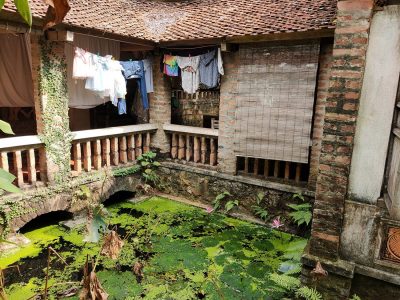

Dinner at the studio. Shared meals was always our greatest gifts.
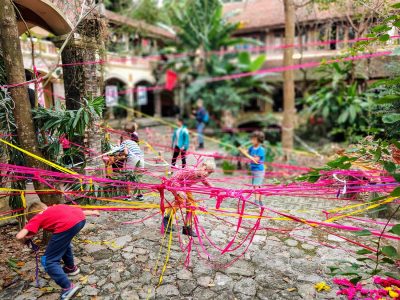

Resident artist Francois Tusseki adding bespoke typography to the residency motorbike.

Artist Nguyễn Thị Mộng Bích arranging flowers from her garden. Bà Bích moved to the village in the 90s, her son – artist and architect Bùi Hoài Mai – redesigning her house and later opening the ceramic studio Hiên Vân Ceramics.
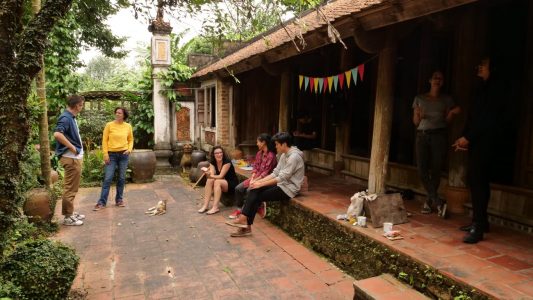
Resident artists at a Sharing Day, the biweekly events gave space for each person to update the group on their work’s progress.


Resident artists Simon Medard and Sylvie Meltzer. Coffee. Always coffee.
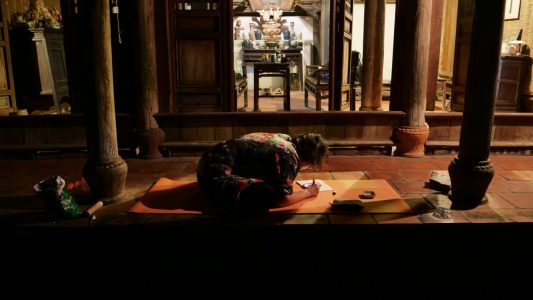
Resident artist Louise Devin, nighttime-yoga mat ceramic designing. Evening air usually bought a welcome chill.
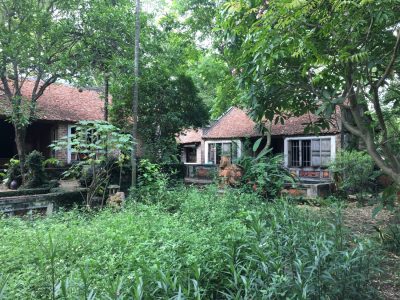
live.make.share’s first housing accommodation, property of Bà Bích’s younger son Linh.
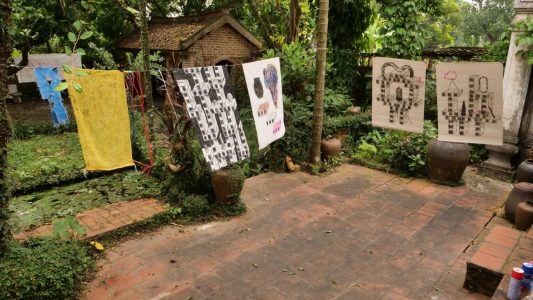
Written reflection - the live.make.share residency programme.
This written reflection concerns the artist-in-residency programme live.make.share (lms) that I conceptualised, developed and hosted from 2017 to 2024 in Hiên Vân, Bac Ninh Province, Vietnam. lms was an intimate project. My personal narrative and curiosities were deeply intertwined, and it informed much of my development working as an arts manager in the space of cultural exchange.
Daughter to a French mother and Vietnamese father, I was born and raised in Australia, removed from Vietnamese culture. After completing my photography studies in Belgium, I worked in various roles in Contemporary Art, moving through Berlin and Montreal, then Brussels where with some friends we formed Undecided Productions (UP).
UP was born from late night banter, hoping to push underrepresented artists into view, we had raucous fun hosting exhibitions, screenings, performances, workshops, often in public spaces with few resources, we were gritty and wild. But perhaps too provocative…as complaints gathered from neighbours of our exhibition space HIDDEN, our lease renewal was proposed conditionally; upon pre-approval of exhibition contents. Choosing not to engage with this process HIDDEN was abandoned, and disheartened I lost interest in public events. Growing a yearning to support artists in earlier stages of research, artist residency structures drew my attention.
Arriving in Hanoi in late 2016, it was artist Tuan Mami that introduced me to the village of Hiên Vân - an hour from the city - where he was making works in the studio of Hiên Vân Ceramics. On this magically sunny day I was introduced to Bùi Hoài Mai, the founder of the studio, and most importantly his mother Bà Mộng Bích, who was to become my guiding light. Sharing tea and fruit, I felt enamoured and accepted into a family of artists who naturally demurred through the sharing of their daily culture.
It was confronting to realise how little I knew, though equally confronting to realise how strongly my “Western” values had been ingrained. Working in North Vietnam runs on a particular timescale that takes some adjusting to, and an understanding of Confucian philosophy would have helped me greatly in these initial days. I also found it very difficult to absorb the patriarchal values that are prevalent in the Vietnamese countryside, and had many times had to reflect on how to act without compromising my deeply feminist values.
live
Ten months after visiting Hiên Vân I launched the first Open Call. lms was constructed with equal importance given to the living, making and the sharing. From 2017 to the end of 2019, we welcomed over 20 artists during spring and autumn, hosting 4-6 at a time. We lived on top of each other, sharing most meals, and all concerns. The group would move in a flock, generating an energy that was both fantastic and unhinged. A messy party, amidst the production of huge amounts of work in the ceramic studio, the garden, the streets and all surfaces in between.
make
I encouraged artists to veer from their projects. Removing any obligation to complete a work, I attempted to challenge the notion of productivity as disconnected from daily life. We made space for fun, believing that the experience of living in Hiên Vân would inevitably impact the artist's productions.
This was proof of a rather large shift in my work. Where UP in Belgium felt cerebral - a purposeful rebellion against systems - lms was more sensual. How does this humidity make me feel? What am I learning from it? How does this air influence my work?
My role as host was less about producing works, rather preparing spaces for discussion, nourishing energy with rest, and creating trust-bubbles where thoughts could be shared openly. The hope being that a joyful experience could lead all involved to deeper understandings of multi-perspectives. As an active participant, I myself learnt greatly. Observing how each artist, artist's assistant, craftsman interacted with each other and their surroundings, introduced thoughts I would have never generated in isolation.
share
The project's engagement with the local community was a contested point. The village was mostly agrarian, but unlike others is not traditionally involved in craft. Villagers were generally disinterested in Contemporary Artists' work, which I found liberating but was problematic for some. Career artists in the West often harbour a dangerous sense of self-importance, but rather than attempting to ignite interest where there was none, we created semi-formal internal meetings where everyone was given space to present/question their work. These “Sharing Days” were my favourite moments, a celebration of curiosity, generous support and touching moments that displayed the trust the residents had in each other and in the programme.
Covid-19
- I cancel a cohort of residents. lms was always tactile, sensorial, and I knew no online variant would ever vibe. Unable to visit Hiên Vân for months, I worked on two large online projects, later happily concluding that screen-initiatives were not for me.
Borders opened in Vietnam in 2022 and we lease an abandoned farmhouse to reopen lms. The smaller structure felt full of love and good intentions, and lms flourished quietly. With only two artists at a time we were able to connect profoundly and with deeper intent. The artists were paired with what I perceived as similar interests, and in our temporary home we had conversations that led to intimate engagements. This final year of the project felt to be our most successful and peaceful moment.
After a two year bureaucratic warzone, I had managed to register UP as an INGO (International Non-Government Organisation). But the unique status came with a cascade of administrative constraints, and announced the impossibility of continuing lms within the “rules”. I painfully decided to pack up.
On a personal level I had begun to feel disconnected from my life-partner, and hosting artists all year had exhausted my resources of care. Even if lms was an informal environment, I took it very seriously and would devote much energy into everyone’s wellbeing. Each artist’s hurdle informed evolutions in my practice, nudging me to rethink and reaffirm the values I seek.Closing the project I attempted to honour all efforts, contacting those involved with gratitude and gifts. Burning rituals thanked the spaces, and our goods were gifted. Administratively I shared a package of templates in the hope that the systems I had finetuned would be useful for future residency managers.
I still visit Ba sometimes, and am forever indebted to the mornings we were able to share.
ELISE HONG ANH LUONG
based in Australia, Vietnam, Europe
HOST
Residency period: 2018 - 2024
sống tại Úc, Việt Nam, Châu Âu
CHỦ NHÀ
Thời gian lưu trú: 2018 - 2024
